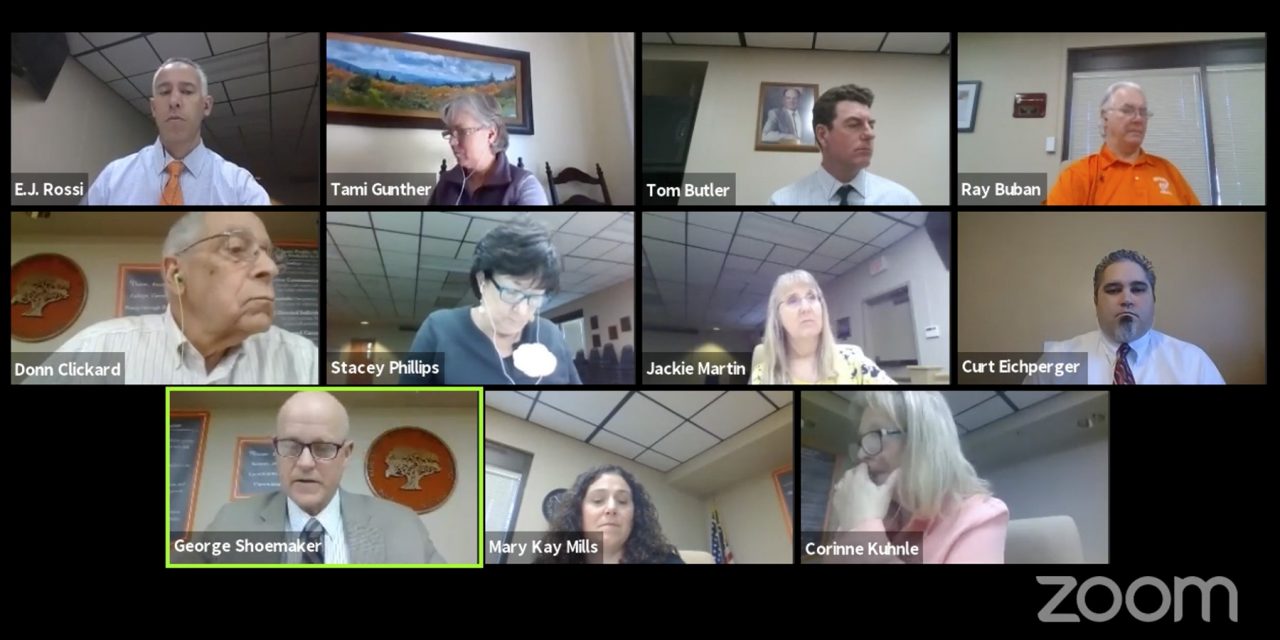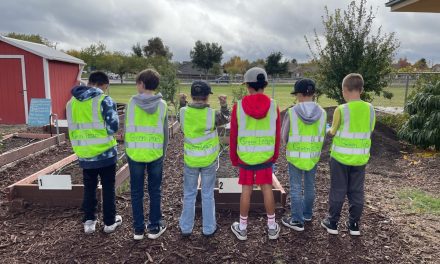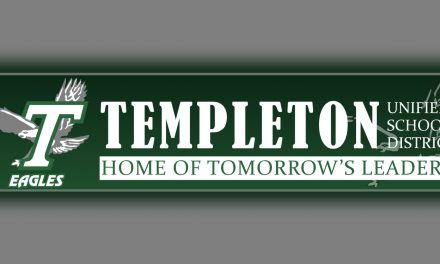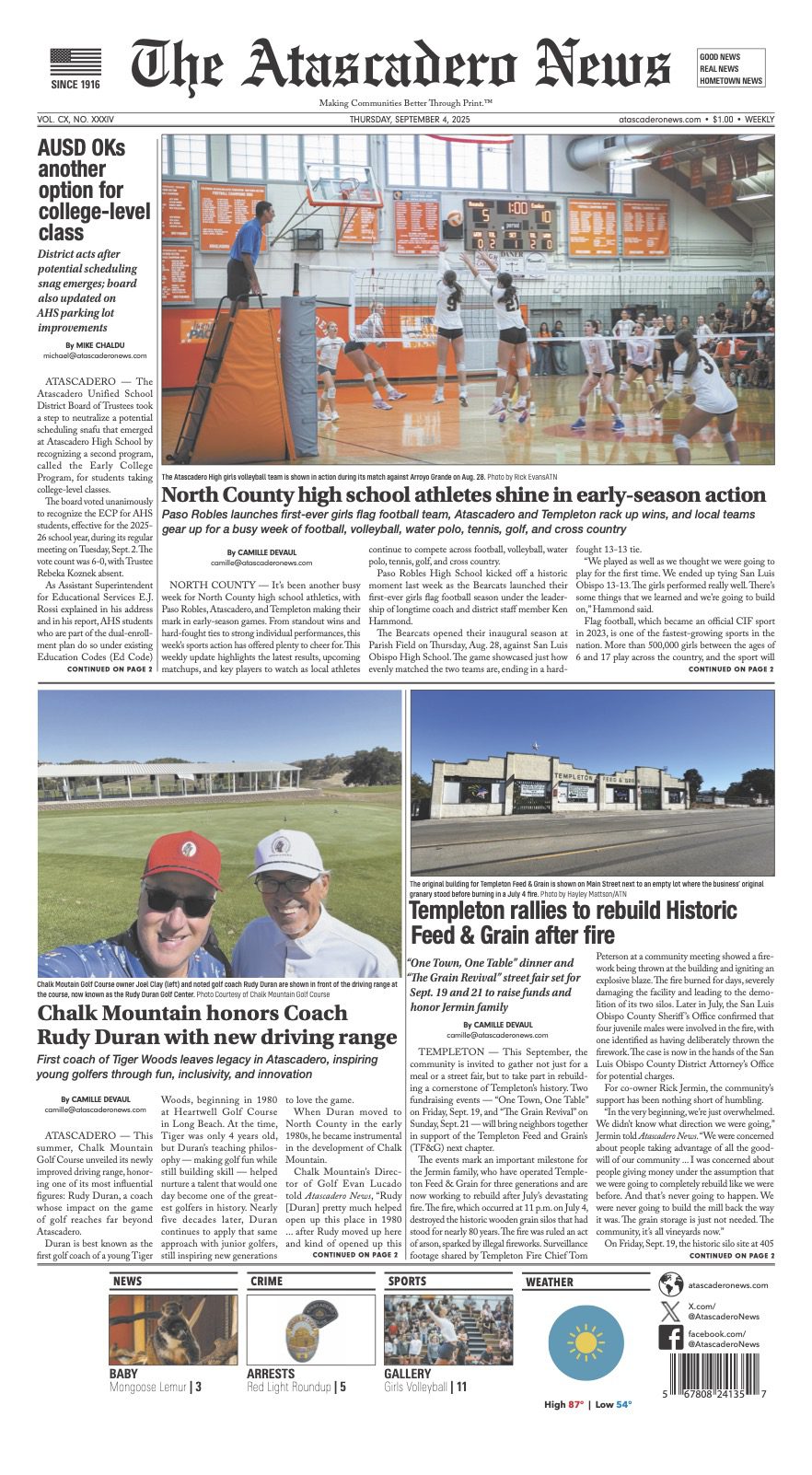Atascadero schools plan for uncertainty heading through 2020
On April 21, the Atascadero Unified School District met at its regular board of trustees meeting, with several members showing up at the district office, and some joining the broadcast Zoom call from home. The Zoom broadcast is available at the AUSD YouTube page for review.
During the meeting, Assistant Superintendent of Business Services Jackie Martin gave a financial update which reported where the district is able to make savings, including lower utility bills, travel expenses and reduced need for filling of dozens of open positions around the district.
District Superintendent Tom Butler reported on the COVID-19 status and the impact on the district. AUSD schools have adapted to online distance learning since the closure of the schools on March 16, and the district currently works toward the end of the regular school year with uncertainties looming around school reopening for the fall as well as financial constraints that seem imminent due to the onset of economic recession.
“Currently the County of San Luis Obispo has extended the stay-at-home order until May 16,” Butler said, “we are all hopeful that our county will get well and we will see a relaxation in the requirements. We monitor that carefully so that we can have our district in the right position to meet whatever health status we are in.”
Distance Learning
Butler leads the district through the current unknowns and adaptations, and prepares the district for the future unknowns and adaptations. In the face of the current circumstances, Butler said the district is making a focused effort toward meeting students’ needs, first and foremost.
“We have weekly meeting with all our district management employees, and the primary topic of those meetings is how are we supporting students, staff and parents,” Butler said. “Yes, there are a lot of burdens on our staff but we have to be mindful of our students — they are our end users, and our parents are our biggest clients. We have to really be thoughtful about them.”
With the adaptation to distance learning, with students working with teachers in a virtual classroom by means of district Chromebooks, student engagement is a top concern for the district.
“On April 10, we had 90 percent of our students engaging in distance learning,” Butler said. “Today, we had about 95 percent. That is a reflection they have internet access and supplies. Our teachers are going to be judging the quantity and quality of the work they do. The teachers remain responsible for the grading and assessment of that learning.”
As the students and teachers close out the final weeks of the 2019-2020 school year in an unexpected environment, the state mandates for education have kept standards that districts must meet. The difficulty in maintaining grades in an environment students and teachers were not prepared for presents problems for seniors who will graduate, but also those younger students still years away from graduating.
“The State guidelines state that ‘no student should be harmed’ in this new environment,” Butler said. “So, that means no grades should go backwards from where they were in the third quarter. We did our own research on this, and looked back five years and saw a light trend, but consistent, that every year students’ grades gradually go up from the third quarter to the final semester … we have that history.”
Seniors are already working with post-high school destinations, and final grades are simply a confirmation of completion that will forever be accompanied by an asterisk relative to COVID-19. Butler maintained that the concern for the district was more with the ninth, 10th, and 11th graders who are still working toward grades that will be looked at by institutions of higher education.
“Our 9th, 10th and 11th graders in the future are going to have to apply to trade schools, colleges and community colleges, and we want our transcripts to put our students in the strongest position possible,” Butler said. “I think this policy does that.”
Also of concern is the elementary and middle school students who make up the vast majority of the student population. Engaging with 90 to 95 percent of students leaves a great many students unaccounted for, and without a school site for them to attend has made things more difficult for teachers to engage those who are not regularly attending.
“Each school site continues to actively pursue families and children who aren’t connecting with us, this is almost investigative in nature,” Butler said. “We are documenting our efforts. We document every phone call. We document the outreach. We talk about different strategies to try to reach families — we still have a small percentage that are not with us regularly.”
The school district is working to maintain state standards of education, and absence from school is not excused automatically due to COVID-19. Butler said that the school is not looking to take punitive action against those who are not attending, but did not waive the possibility in the future.
“Education is mandatory,” Butler said. “It remains mandatory, but there is a fantastic effort to reach those in need.”
The district food service is meeting another widespread and mandatory need — feeding the district student population while schools remain closed. Three sites in the district provide drive-through meal programs — San Benito Road Elementary, Santa Rosa Academic Academy, and Atascadero Middle School.
“On a weekly basis, we are delivering 2,500 meals,” Butler said. “That is two meals, a breakfast and a lunch, so that is actually 5,000 meals.”
The district is working on funding from the federal government to offset the cost of the meal service, which is providing meals to all residents under the age of 18.
“Usually, we don’t provide meals for one-year-olds,” Butler said. “Right now, we do. We think it has been very helpful.”
Fiscal Management
“We are working diligently to manage our financing,” Butler said. “I appreciate the trustees’ direction to maintain fiscal solvency. It has been a hallmark of this district to meet our obligations. We are thoughtful about our impact to our employees as well as our educational programs. That is a high priority, top effort of the management team that spends hours on this daily to hopefully put us in the best position we can as we head into a deeper recession.”
Uncertainty abounds for the upcoming school year — both from a financial position and a health perspective. The district is producing a plan for contingencies in case schools remain closed, partially or completely, to start the 2020-2021 school year. Butler said the district is working closely with the classified association and teachers’ association to plan a “safety net” for the district.
“We do not want to be scrambling at the last minute if things change,” Butler said. “We absolutely want regular school back as soon as we can, but we have to be responsible as we can in regards to state guidelines and the status in our county. So, we will build backup plans with our partners.”
In the face of uncertainty, the district was poised to decide on pay increases for administration. Following pay increases from 2019 for the AUSD teachers and other services, the certificated and classified management salaries were scheduled for an increase of the same 1.25 percent. The subject was put to vote, with trustee George Shoemaker standing out as the dissenting voice, citing financial uncertainty.
“As a reminder, we did approve ATA’s [Atascadero Teacher’s Association] 1.25 in November,” Martin said. “Confidential supervisory and special services 1.25 percent increase back in December, and we have on the table the CSEA’s 1.25 at this time.”
Shoemaker spoke a word of caution against moving forward with the approval of the raise while looming recession approaches and savings are pursued in all areas around the district.
“We have a very difficult stretch ahead of us, and any funding we have available in the future I can see going to the pay increases,” Shoemaker said, “but at this time, I will be opposed to any increase for any salaries as long as other funding sources have not been identified.”
The caution was not echoed by the majority of the school board, with advocates of the raise citing the raise as a budgeted item for the 2019-2020 school year. According to information by a school board trustee, the annual cost in the 1.25 percent raise for administration is expected to be approximately $46,000.
“I hear George’s concern,” trustee Tami Gunther said, “but I think this is something we need to do because it is already budgeted. Every employee is just as important as every other employee in this district and what is good for one is good for all. When the time comes, when we need to make cuts, everyone will be making cuts. This is just a matter of equality in my opinion.”
Trustee Corinne Kuhnle voiced support for Gunther’s statement as well, concluding input from trustees.
“This is an opportunity to honor what we have been discussing, and respect every employee,” Kuhnle said. “I’d like to approve this also.”
In the roll call vote, the motion to approve the 1.25 percent pay increase for certificated and classified management, the motion passed 6 to 1, with Shoemaker voting no.














